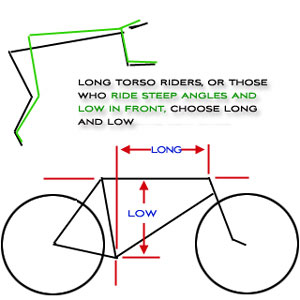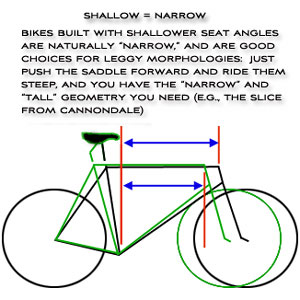Long and low, short and narrow

It's time for bike manufacturers to back their trucks up to their local bike shops, and unload boxes and boxes… and boxes… of bikes your retailer cannot possibly afford.
And the race is on, to sell them before the bills for these bikes come due on or about next May; bills that in the aggregate may total more than your bike shop owner's net worth. If he is good at what he does, his inventory this time of year is threadbare but for the 09 product already delivered, and for inventory he might reasonably expect to sell for Christmas.
This is therefore a great time to buy your 09 tri bike, especially if it's an 08 model you're looking at. Unfortunately, queries from our Slowtwitch forum board's readers — should I buy the Cervelodale P-Slice, or the Specialfelt DA Works? — are almost exclusively devoid of data from which we might draw sensible conclusions.
In very general terms, let me tell you how to know which tri bikes are going to fit you. And these are very general guidelines.
When it comes to bike sizing — not how they're going to handle, just how they're going to fit — there are three things you need to concern yourself with. First…

LONG AND LOW, SHORT AND NARROW, OR IN BETWEEN?
What we're talking about is the relationship between the one point you contact the bike (the bottom bracket) to the other point (the head tube top). Now, you might not immediately stipulate that you contact the bike at these points. But you do. No, you don't stick your big toes in the hole where the bottom bracket is threaded, but you do the next thing to it: you attach to the pedals, which attach to the cranks, which attach to the BB. Likewise, you attach to the aerobars, which attach to the stem, which attaches to the fork steer column, which pivots above the top headseat bearing, which sits at the head tube top.
So, the head tube top's relationship to the BB, this is what we're interested in; this is what will tell you whether the bike is a good fit for you. Where the head tube top is in relation to the BB determines whether you're going to need a stem pitched to high heaven on a bed of spacers; or a stem pointing straight to hell. And, whether that stem is 5cm long, or 14cm long, or just right.
If your frame fits you correctly, the stem is neither skyward nor groundward, nor too long or short. If your frame fits you well, no unnatural stem configuration is required.
STEEP/SHALLOW
All things equal, if you ride with a steep seat angle — if your saddle is forward relative to your bottom bracket — you'll need a "long" bike, not a "narrow" bike. Why? Because when you ride your bike steep, and that saddle is pushed forward, that pushes the entire front of the bike forward. If you moved your saddle forward 2cm on its rails, you'd need to add 2cm to your stem's length, right? But if your stem is already a good size for you, then wouldn't it be better to make the frame 2cm longer, rather than make the stem 2cm longer?
Now, let's go in the other direction; let's assume you want to ride shallower. In this case, you move your hips in the other direction — rearward relative to your bottom bracket — and this will draw the frame's head tube back, "narrowing" the bike.

MORPHOLOGY
So, all things equal, steep riders need a long bike, shallower-angled riders need a narrower bike. But this is not a hard and fast rule. Certain steep riders might need a taller, narrower bike, namely those with morphology issues. If you've got long legs, you'll need a taller head tube, that is, you need the head tube top to sit up in the air a bit, because your legs perch you up so high. Just as it's hard to buy jeans with a 36" inseam and a 30" waist, it's hard to find bikes that are tall yet with a narrow "waist." But these bikes do exist, and this is the sort of bike you need.
SEAT ANGLE
The spatial relationship between the frame's head tube top and the bottom bracket — it's height and its length, otherwise known as "stack" and "reach" in our bike fit nomenclature — is, as mentioned, the first of three things you ought to know when figuring out which of these closeout bikes from last season might work for you. Again, if you ride steep and with a flat back while in the aero position, you need a bike that's long and low. If you ride shallow, you might be better on a bike that's narrower and taller. Likewise, even if you ride on the steep side, if you're all legs and no torso you still might need a bike that's narrow and tall.
The diagram just above explains how a leggy rider who chooses a steep configuration is a great prospect for a narrow and tall geometry. But these narrow and tall bikes often tend to be shallow seat-angled bikes. This is no problem for you, as long as you're able to get the saddle in the steeper configuration. Many of today's tri bikes have this problem licked, with multiple seat posts or posts with variable positions. Just make sure the bike you're thinking of has this adjustability.

AEROBAR PROFILE
Especially for the leggy among you, even if you choose a tall and narrow geometry you still might find it hard to get the aerobars high enough for you. And this represents the last of three things you can easily do to get the bike to fit. Just as bike frames have a "higher" or "lower" vertical profile, aerobars do too. Some bars have armrests that sit high (6cm or 7cm above the pursuit bar). Many of the Profile Design aerobars are built this way, as is the Syntace bar. Other aerobars feature armrests that sit low, just barely above the pursuit bar. Hed bars are made this way, with armrests that sit only about 2cm above the centerline of the pursuit bar. Visiontech clip-ons have armrests that sit about 3.5cm above.
WHICH BIKES ARE LONG AND LOW, WHICH NARROW AND TALL?
Cervelo and Felt each make tri bikes that are "long" and "low." The same can be said for Kestrel's Airfoil and bikes made by Jamis and Leader. Scott's Plasma and Cannondale's Slice are taller and narrower. Trek's Equinox TTX is also in that category.
Some bike makers have a split personality. Kuota's Kueen K, Argon 18's E112 and 114, Quintana Roo's Kilo and Tequilo, are all long and low. Kuota's Kalibur, Argon 18's Mercury, QR's Lucero and other carbon frames, are all on the narrower side.
The best way to understand the posture, or orientation, of a tri bike you're looking at is by familiarizing yourself with our stack and reach database, where we compare all these bikes. Felt's 52cm size features a "stack" of 50cm and a "reach" of 40.5cm. A "stack" of 50cm ls considered relatively low for a bike of that size, and a reach of 40.5cm is long for a bike of that size. Trek's Equinox TTX in size "small" has a stack of 52cm and a reach of 39cm. As you see, that's a taller bike, but a narrower one. These two bikes are made to fit the same size person, as far as it goes. But the Felt is more likely to fit a person of average proportion, while the Trek is likely to fit a leggier person with a shorter torso.
But the Felt might fit the leggier rider under two conditions: that the Felt is ridden quite steep, and if the rider chooses an aerobar with armrests that sit well above the centerline of the pursuit bar. Those high profile armrests suck up space that would otherwise be filled by a frame's head tube (the Trek has that longer head tube, the Felt does not).
This is the sort of calculus that goes into determining whether a bike will fit you. If it seems technical, it is. Not one bike shop in 10 knows this stuff — and many still don't understand it after having it explained to them.
For further elucidation, follow the links at the bottom of this page, as well as the links at the bottom of these related pages. The more you read, the more you'll begin to appreciate what styles of bikes might be best suited to your riding and morphological idiosyncrasies.





Start the discussion at forum.slowtwitch.com